Family : Carangidae

Text © Giuseppe Mazza

English translation by Mario Beltramini
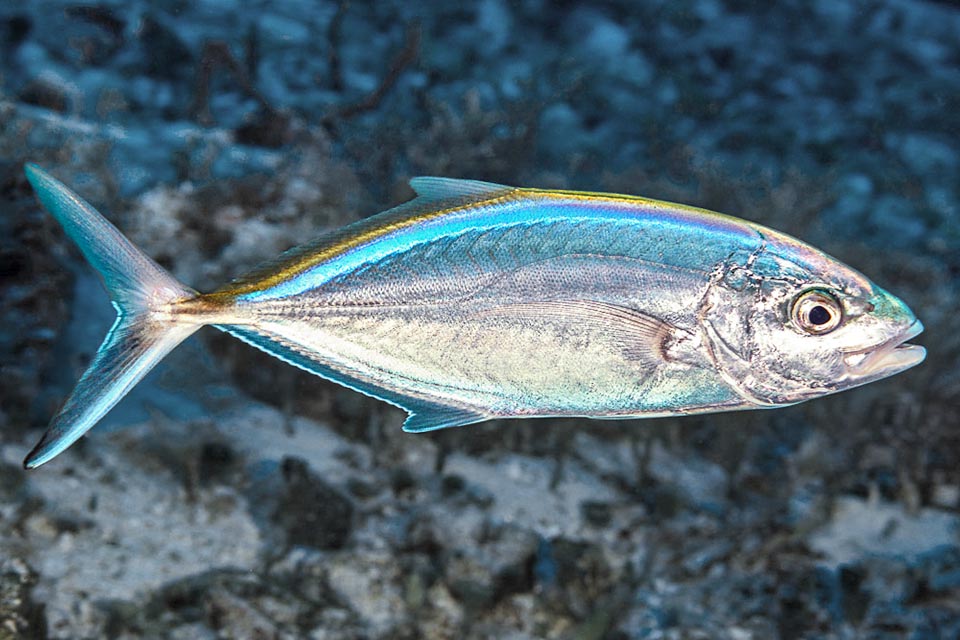
Usually 40 cm long, Caranx ruber is present in western Atlantic tropical and subtropical waters © François Libert
Caranx ruber (Bloch, 1793), called Bar jack, belongs to the class of the Actinopterygii, the ray-finned fishes, to the order of the Perciformes and to the family of the Carangidae that counting about 30 genera and 150 species. Marine fishes with the body usually compressed on the sides, fast swimming predators, common in the tropical waters and present also in the Mediterranean.
The genus Caranx comes from “carangue”, name that the Antillean French gave to these fishes, whilst the specific term ruber, red, does not come from the real colour of the fish but probably from that of the conserved fish the Author used for the description of the species.
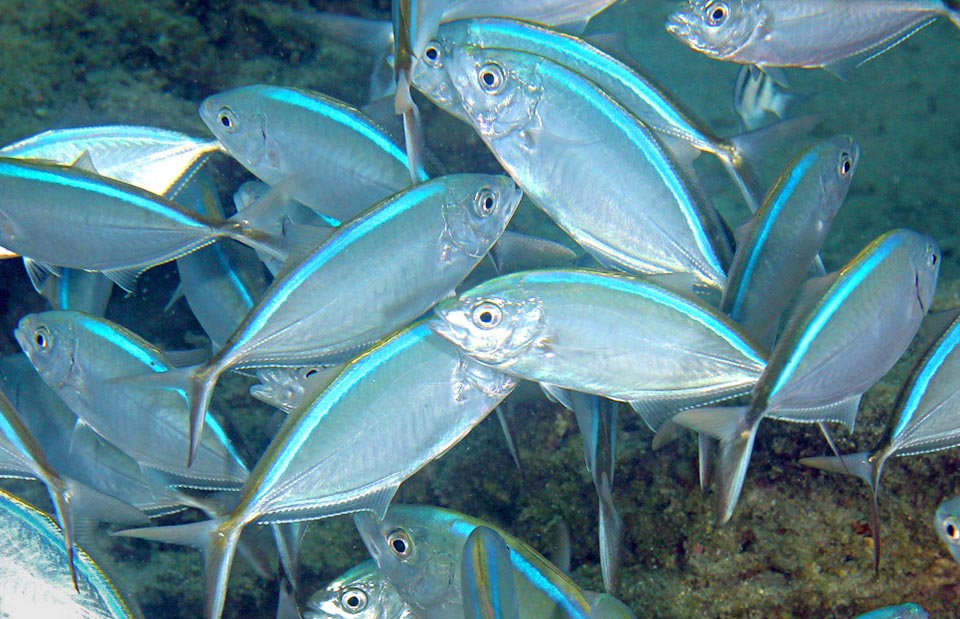
It’s a benthopelagic species mainly moving in schools, often fragmented in small groups in mid-water or on the bottoms © Kevin Bryant
Zoogeography
Caranx ruber is present in the tropical and subtropical western Atlantic waters, from the Bermudas and New Jersey to the Gulf of Mexico, Venezuela and the north of Brazil. Very common in the Caribbean and in the West Indies, it looks like it has been sighted also in St Helena Island and along the coasts of Rio de Janeiro that should mark the southernmost limit of the species.
There are also reports of sightings at the Açores. The juveniles, pelagic, in fact grow up hidden under the carpets of drifting sargassoes and this might explain the presence of the species in far away lands.
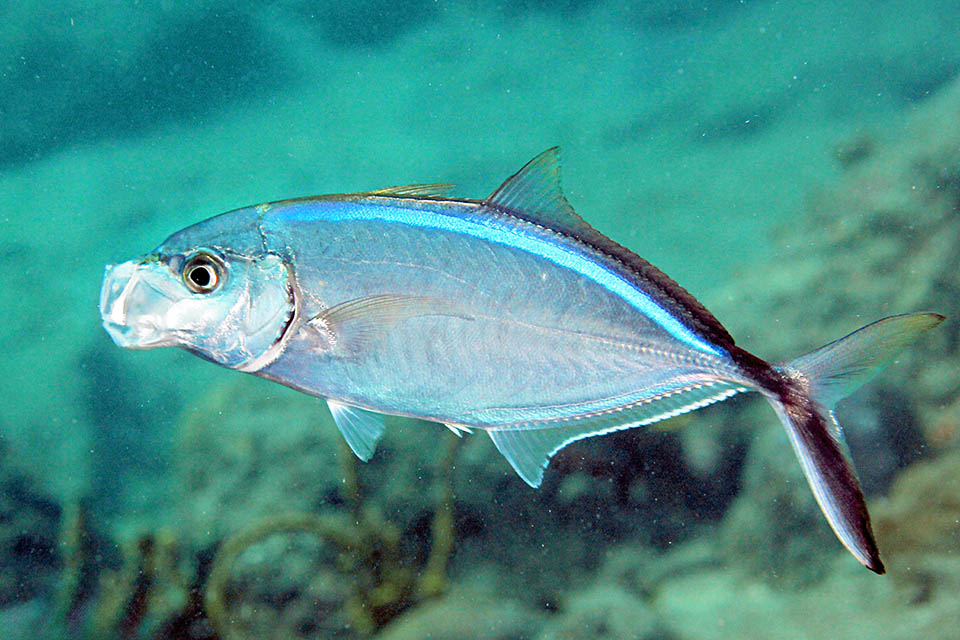
Here we note all the characteristics of this species: the long dorsal bar, crossing the peduncle and then the lower lobe of the caudal fin sided by a showy turquoise electric blue bar, the caudal as falcate as the pectoral fins, both done for fast swoops, the protractile mouth, the two tiny ventral spines and the first dorsal fin © Kevin Bryant
Ecology-Habitat
It is a fish living mainly in schools, often fragmented in small ones, in the clear insular waters or of the shallow coral reefs off the continental coasts, without going down beyond the depth of 22 m.
It mainly goes swimming on the seabeds or mid-water where it finds its preys, sandy zones, madreporic formations and submerged prairies of phanerogams.
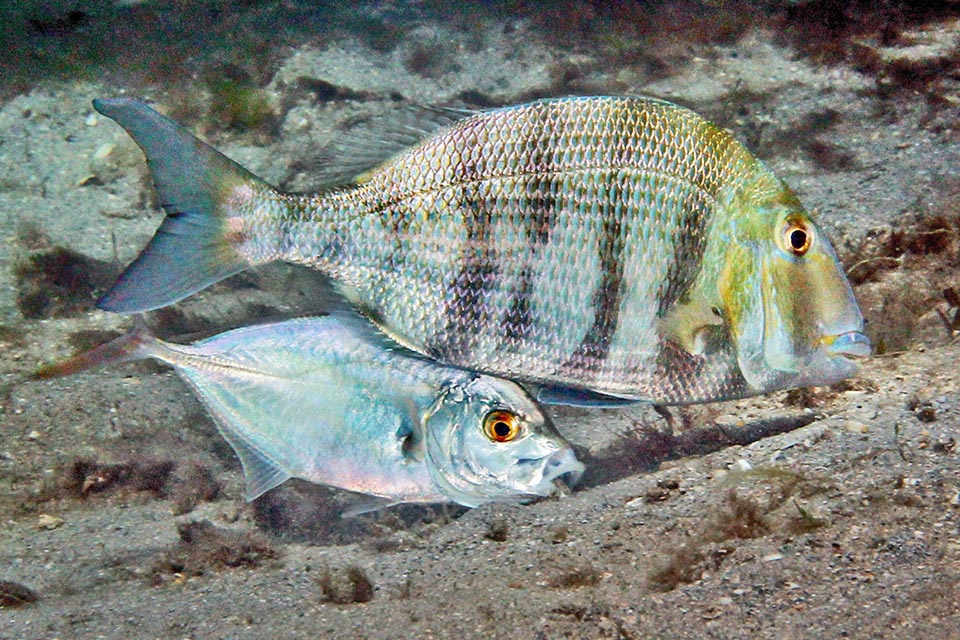
Caranx ruber is a smart fish who follows various hunting masters, stealing them, like this Calamus penna, what they find on the seabeds © Kevin Bryant
Morphophysiology
Caranx ruber can reach 73 cm and 8,2 kg, but rarely exceeds half metre. The body, moderately compressed, appears with an elongated profile perfectly symmetrical, almond shaped, that ends in a thin caudal peduncle bearing falcate fins like the pectoral, for a fast swimming.
The protractile mouth is armed with narrow bands of villiform teeth to which add, up, some canines curved and spaced for holding the preys. The lateral line, with the typical curved shape of the carangids, has in its final straight part 23-29 spiny bony scutes on the peduncle.
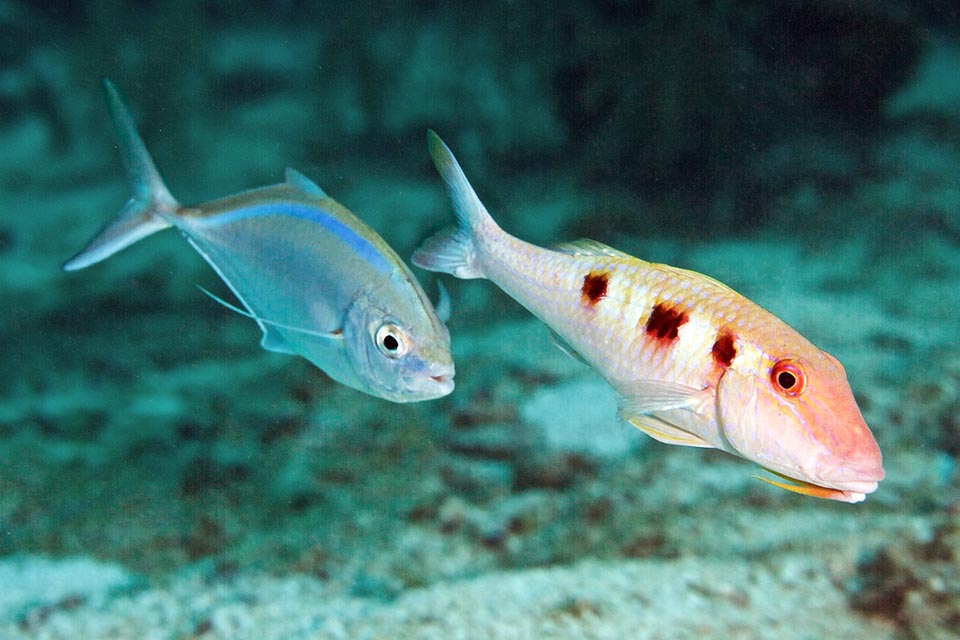
Here it pursues profitably a Caribbean mullet, Pseudopeneus maculatus, hunting small crustaceans, mollusks and tasty small worms © Allison & Carlos Estape
There are two dorsal fins: the first, folded while swimming, has 8 spiny rays and the second one spine followed by 26-30 soft rays. The anal displays 2 spines and after a small break stands a spiny ray followed by 23-26 soft rays. After the pelvic, in front of the anus, we note two small spines pointing towards the tail. Unlike Caranx hippos the chest is completely scaled.
The silvery livery, bluish grey on the back, fades ventrally to white. Characteristic is the dorsal black band that, following on the peduncle, crosses the lower lobe of the caudal fin sides by a showy electric blue colour. Between the two, on the back, we also note a thin yellow stripe.
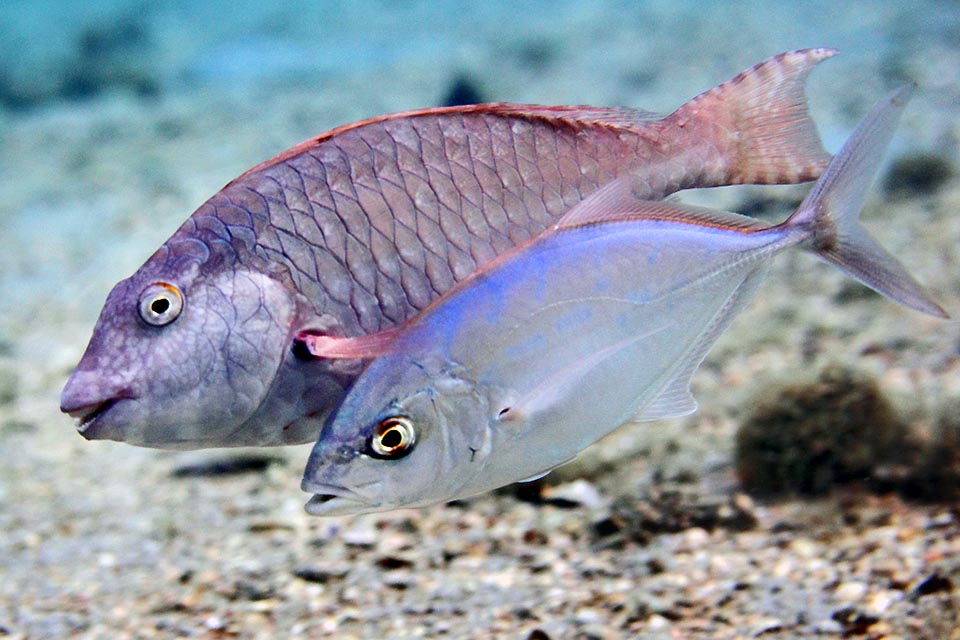
A Sparisoma here smiles at it, because the parrotfishes eat algae and madrepores, but the lesson was useful, because in Cuba Caranx ruber eats also plants © Kevin Bryant
As often happens in the world of fishes, the livery changes also depending on the mood of the fish and the mimetic necessities. Therefore when it is hunting on the bottom the body turns blackish bronze, whilst the silvery blue shades are predominant if it is preying on pelagic fishes.
When about 2 cm, the juveniles present 6 dark mimetic vertical bands that disappear as soon as they reach 6 cm to appear again when adults in the form of thin clear lines more or less continuous when the fish is particularly stressed, like when the sport fishermen remove it from the hook.
Ethology-Reproductive Biology
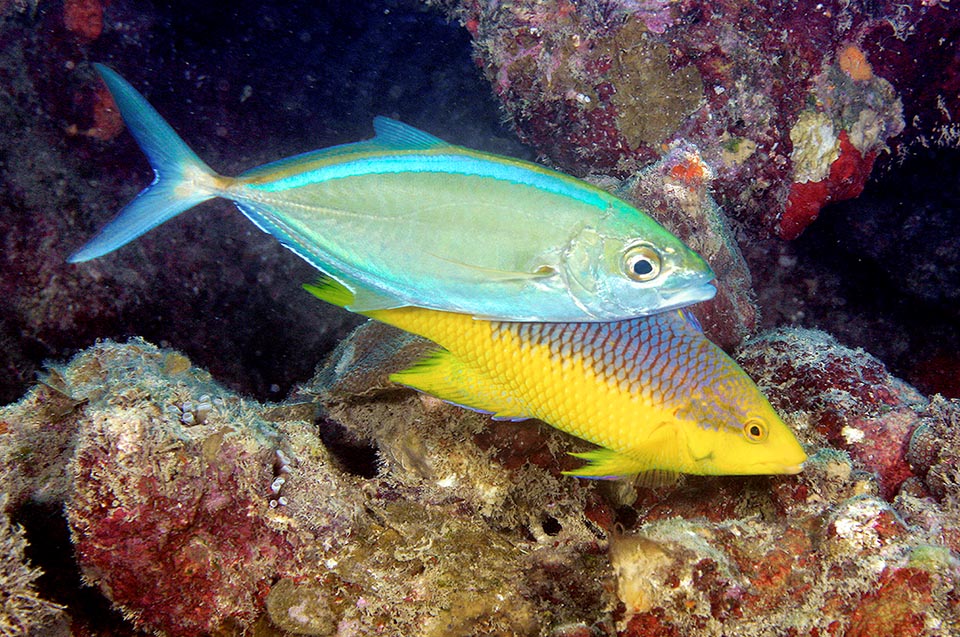
Here with a Bodianus rufus, labrid that feeds driving out on the seabeds gastropods, bivalves, and crustaceans © Kevin Bryant
Caranx ruber is a diurnal predator hunting on sight small fishes such as blennies, gobies, butterflyfishes and labrids, but also cephalopods, shrimps and other benthic species.
It has also the habit of quickly stealing, from the dish, the preyes hunted by other species, plus discovering their hunting techniques with new food experiences.
Thus it follows the parrotfishes like Sparisoma chrysopterum, sparids like Calamus penna or labrids like Bodianus rufus who look for crabs or small worms, or the big Lachnolaimus maximus who moves the sand of the seabeds with strong jets of water from the mouth.
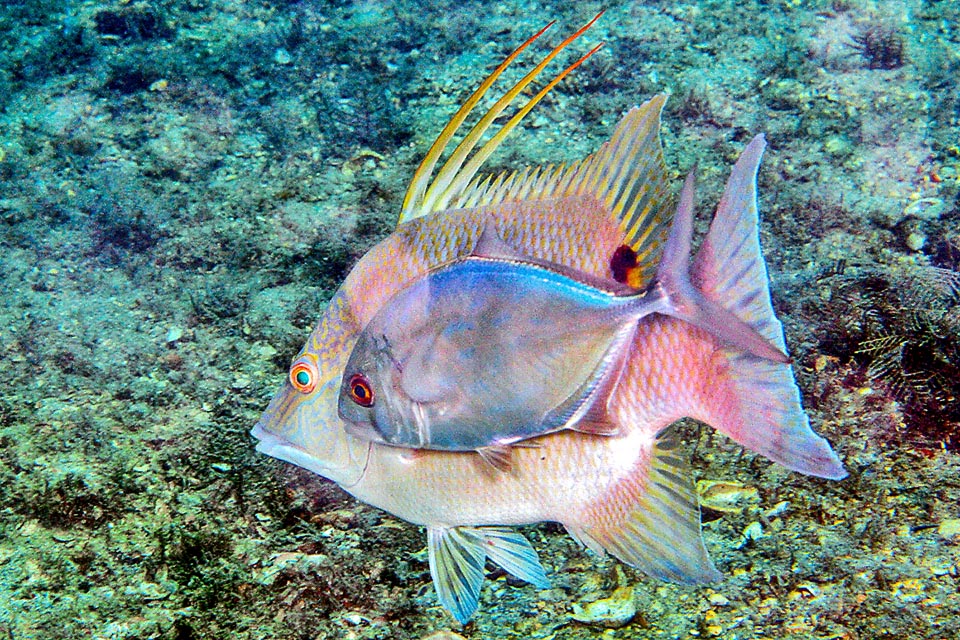
Also Lachnolaimus maximus, who discovers the preys with jets of water on the sand is a good teacher, and to be welcome Caranx ruber imitates its colour © Kevin Bryant
Also plate fishes like Bothus lunatus and spotted goatfishes like Pseudupeneus maculatus stand among its victims, and often with its greediness ends up swallowing fragments of madrepores and shells.
Caranx ruber does not even hesitate to follow cautiously the Great barracuda (Sphyraena barracuda) to swoop fast on small fishes that run away terrified at the sight of this marauder.
Conversely, among its main predators stand the big carangids, the Common dolphinfish (Coryphaena hippurus), the Blue marlin (Makaira nigricans), the Greater amberjack (Seriola dumerili), the King mackerel (Scomberomorus cavalla), the big groupers, the dolphins and various sae birds.
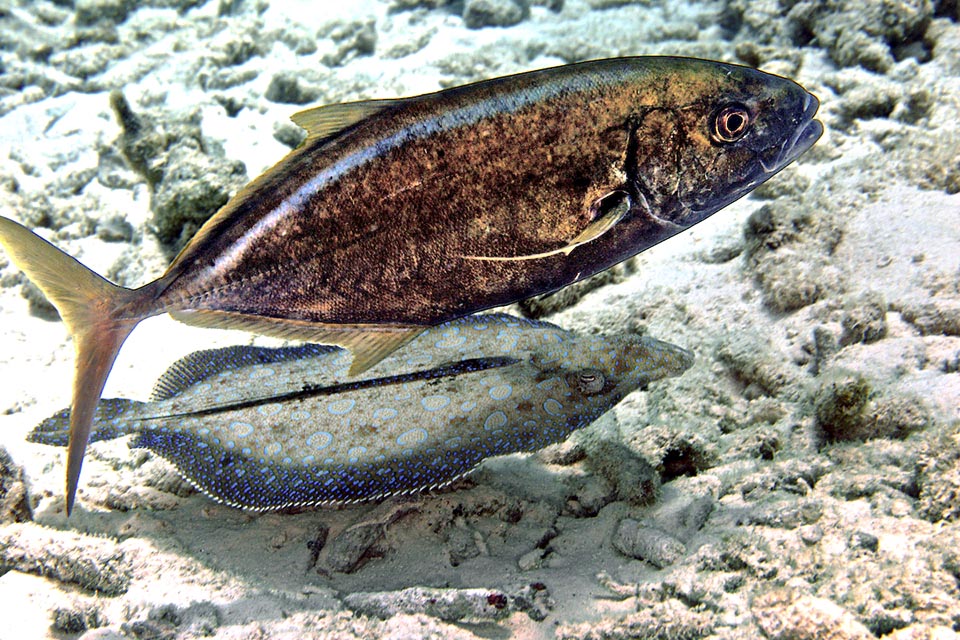
Here is with Bothus lunatus, a turbot greedy of mollusks, crustaceans and worms, and when moving on bottoms Caranx ruber often uses a bronze, at times black, livery © Allison & Carlos Estape
The reproduction of Caranx ruber may occur all over the year, with peaks in March-April and June-July.
For the occasion, in some sites, we note dense aggregations with hundreds of individuals, but spawning does not take place in mass: couples talke form who momentarily separate from the school to lay and fecundate thousands of eggs entrusted to the currents, and also the larvae, that upon hatching measure 2 mm, are pelagic.
The juveniles grow up nourishing of plankton they swallow ceaselessly on the surface, every 5-7 seconds, as long as there is light.
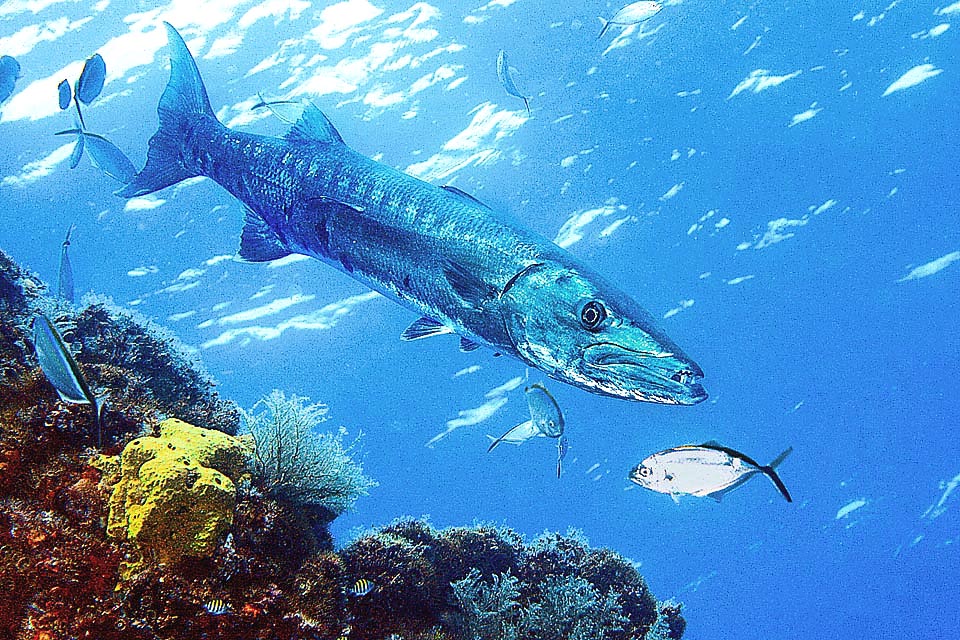
Also the Great barracuda (Sphyraena barracuda) can be useful, because when they see it the small fishes run away terrified and Caranx ruber seizes them © Kevin Bryant
When they reach sexual maturity, the males about 26 cm in length and the females 31 cm, change their diet and prey on small fishes and crustaceans, whilst the seniors feed almost exclusively on fishes.
Caranx ruber is widely fished in the Caribbean, with dragnets or trawls, and they are talking of 15 tons per year.
The quality of the flesh is mediocre, excellent only for the sport fishermen who however must be careful, when they they catch large specimens, for a possible, though weak, risk of ciguatera, severe food poisoning possible when these fishes prey upon species that store in their diet the toxin produced by the dinoflagellate Gambierdiscus toxicus.
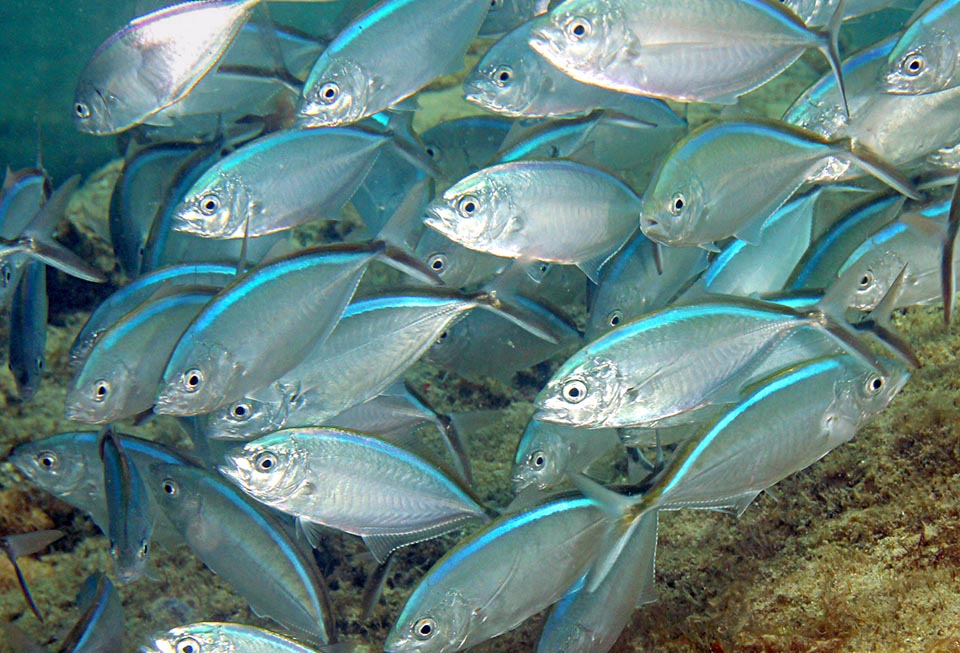
Caranx ruber reproduction may occur all over the year with peaks in March-April and June-July. Even if fished a lot, it is not an endangered species © Kevin Bryant
The resilience of the species is mediocre with a possible doubling of the populations in 1,4-4,4 years and the fishing vulnerability of the species, high, marks 57 on a scale of 100.
However, Caranx ruber still appears in the IUCN Red List of the endangered species as “Least Concern” , that is, at “Minimal Concern”.
Synonyms
Scomber ruber Bloch, 1793; Carangoides ruber (Bloch, 1793).
→ For general information about FISH please click here.
→ For general information about BONY FISH please click here
→ For general information about CARTILAGINOUS FISH please click here.
→ To appreciate the BIODIVERSITY of BONY FISH please click here.
→ To appreciate the BIODIVERSITY of CARTILAGINOUS FISH please click here.
